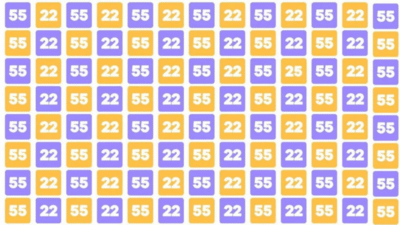
Here's a new challenge: amidst a sea of identical pairs, participants are tasked with identifying the single number '25' hidden among them. This puzzle not only offers entertainment but also serves as a test of one's attention to detail and pattern recognition skills .
The puzzle is a grid of identical number pairs. On first glance, the grid looks uniform, but in this array, there is a single '25' that does not have a pair. The task is to find this lone number as quickly as possible.
Participants are given the task of finding the solitary '25' among the pairs within as little time as possible. This makes it a challenging time-bound game that forces the individual to focus intensely and process visual information very quickly. Optical illusions captivate us because they play with our perception, often revealing the complexities of how our brains interpret visual information. They show that what we see is not necessarily a direct reflection of reality, but rather a construction of the brain.
Here's how to solve it
To effectively tackle this puzzle, consider the following approaches:
Systematic scanning: Instead of randomly glancing over the grid, scan each row or column methodically. This structured approach reduces the likelihood of missing the solitary number.
Pattern recognition: Familiarize yourself with the pairs' patterns. Once you recognize the common pairs, the outlier—the single '25'—will be easier to spot.
Time management: Given the typical 10-second limit, allocate your time wisely. If the grid is extensive, divide it into sections and focus on one area at a time.
Stay calm: Maintaining composure is crucial. Anxiety can cloud judgment and slow down cognitive processing. Take a deep breath and approach the puzzle with a clear mind.
Benefits of engaging in such puzzles
Several cognitive abilities are developed through optical illusions and brain teasers . The repeated practice allows people to recognize minute differences as well as discrepancies that occur in general surroundings. While working to find required elements within a complex pattern develops the capacity to focus for extended periods. Time-limited challenges allow individuals to quickly process information for better processing. Solving puzzles works as an exercise to ease the mind by distracting it from the stress of everyday life.
Answer

The puzzle is not a pastime but an exercise that challenges and improves our cognitive faculties. Doing this is entertaining us, but at the same time, it is stimulating mental agility and acuity. The next time you find yourself in such a situation, do not take it as a distraction but rather as a chance to hone your mind and enjoy the intricate workings of human perception.
 Here's a new challenge: amidst a sea of identical pairs, participants are tasked with identifying the single number '25' hidden among them. This puzzle not only offers entertainment but also serves as a test of one's attention to detail and pattern recognition skills .
Here's a new challenge: amidst a sea of identical pairs, participants are tasked with identifying the single number '25' hidden among them. This puzzle not only offers entertainment but also serves as a test of one's attention to detail and pattern recognition skills .
